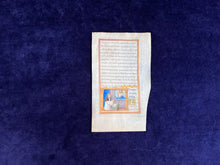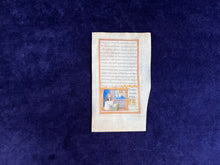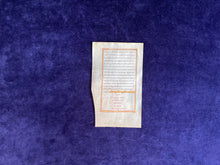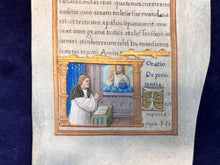Details:
Italy, mid to late 15th c. (130 x 75mm ). Latin. 21 lines of Humanist script. Illustration of Dominican cleric worshipping Christ, flanked by columns, single 3-line initial with poppy embellishments, two branch line fillers, surrounded by a triple border in gold and red. Parchment appears to have been taken from shoulder of animal, evidenced by dip on fore-edge side. Pricking marks at the edge of the border.
Description & Historical Context:
The text of this leaf celebrates the Feast of John the Baptist with St. Anselm’s Meditations I, De Timore Mortis, or, On the Fear of Death. The Italian Anselm held the office of Archbishop of Canterbury in the early 12th century and, significant to this leaf, was a Benedictine monk. The Benedictine monks were often referred to as the Black Monks for their black habits to symbolise death, penitence, and their vows of poverty. The figure in the illustration, however, wears the habit of a Dominican monk— a white tunic with a black cowl— indicating that this is not a portrait of the author of the text, St. Anselm, but likely, a portrait of the patron himself.
This gives us a peak at the original owner of this manuscript. He appears to be a young man, with ruddy cheeks and a full head of hair, lacking only his tonsured top to show his holiness. His devotion to God is further emphasised by the open book in front of him, likely guiding his meditations on the Lord, to whom he offers his eyes and hands, gazing at the holy figure before him. Christ is depicted among blue swirls of clouds, holding a sphere, with his hand raised in benediction. To commission a book like this would not be a cheap undertaking, which perhaps is why an imperfect shoulder-piece of parchment was used for this otherwise luxurious folio.
The script is particularly legible to our modern eyes as it is the one that the font Times New Roman was developed from. In the 1300s, several scholar/authors, such as Petrarch and Poggio Bracciolini, decided that the Gothic script of the earlier generations had become too ponderous to read and wanted to return to what they thought was a Classical Roman style of script. Re-employing the ampersand, ligatures between st and ct consonant clusters, and using minimal abbreviations, the light and airy Humanist hand was a rebirth of the Carolingian minuscule of the 9th-11th centuries rather than a true Roman script. The development of the Humanist script, with the intention of reviving the Classics, is a beautiful misunderstanding of history and begins the slow march of the Renaissance to devalue the Medieval in favour of the Greco-Roman culture, overlooking the contributions of the Middle Ages.
Latin Text:
- sime praecursor Christi, praeco Judicis, amic(us)
sponsi. vox verbi divini, qui solatium n(ost)re
redemptionis annuntiare meruisti impe-
-tra mihi misero apud eundem dominum
nostrum Jesum Christum tuis sanctissimis
precibus. ut purgato a vitiis pectore et
ornato virtutibus parem secundum sa-
-lubria tua monita viam Domini & rectas
faciam semitas eius. quatenus in extremo
iudicio cum aream ecclesiae sue mundave-
-rit et triticum a paleis separaverit me-
-rear inter grana tritici et electos suos in-
-veniri et in horreum celestis mansionis
cum eis reponi Amen.
Oratio/ De Peni/tentia
Ter-
-ret
me vita
mea. Na(mque)
diligenter discussa apparet michi aut pecca-
-tum at sterilitas et in fructuosa et si quis
fructus in ea videtur aut est simulatus aut
imperfectus aut aliquomodo corruptus.
Quid ergo michi restat peccatori nisi ut in
tota vita mea plorem totam vitam meam.
Certus sum domine quia peccata mea eter-
-nam merentur damnatiomen. Certior q(uis)
penitentia mea non sussicit ad satisfationem
Certissimus quia misericordia tua superat
omnem offensionem . Fac ergo mecum mise-
-ricordiam. Et conceded michi peccatorum me
orum indulgentiam quia meritum meum
indulgentia tua est domina deus meus
Amen.
Oratio
De baptismo domini/ Nostri Iesu Cristi
Redemptoris/ per sanctum/
Iohannem prophetam.
MB387








